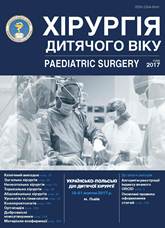Justifiability of expectation of involution in hemangioma program treatment in children
DOI:
https://doi.org/10.15574/PS.2017.56.114Keywords:
children, hemangioma, treatmentsAbstract
Hemangiomas are tumorlike vessel changes that occur in children starting from an early age and can appear as minor cosmetic defects that sometimes spontaneously decrease, or can cause serious functional disorders or even be a threat to life.Objective. To improve treatment outcomes and efficacy in children with hemangіomas of external location by applying the method of classification algorithm.
Material and methods. To study the problem in the Podolsk region of Ukraine, a retrospective clinical study of children with external HA during the last 15 years was conducted. The study included: an analysis of medical records and outpatient cards of children who were treated in-patiently or out-patiently between 2002 to 2017.
Results. According to generalization of treatment outcomes, the selection criteria of hemangioma management, depending upon the stage of development, character of growth, spreading, were elaborated. The programme, which on the one hand makes it possible to use individual approach to treatment, and on the other hand to standardize this treatment approach to achieve maximal cosmetic and functional results, was proposed.
Conclusions. Choice of treatment strategy in children with external hemangiomas must be conducted in each case, except unreasonable expectation of a possible tumor regression. The options ofexternal hemangioma management in children should be based on tumor classification algorithm due to its morphological features.
References
Belysheva ТS. (2012). Breakthrough in the treatment of vascular pathology. The medical bulletin. 25: 66–78.
Bugorkova IA. (2013). Monitoring of the prevalence of hemangiomas in the maxillofacial area among children. Medical and social problems. 18; 4: 83–86.
Vivcharuk VP, Pashchenko YuV, Piontkovskaya OV. (2013). The choice of optimal tactics in the treatment of hemangiomas in children. Medical Prospects. XVIII; 3; 2: 209–213.
Vivcharuk VP, Pashchenko YuV. (2015). Modern possibilities in surgical treatment of extensive hemangiomas in children. Emergency medicine. 4: 22–27.
Melnik DD, Gunter VE, Dambayev GT. (2006). Hemangiomas and their treatment. Tomsk, STT: 168.
Roginsky VV, Nadtochiy AG, Grigoryan AS. (2011). Classification of formations from the blood vessels of the maxillofacial region and neck in children. Stomatology. 4: 71–75.
Kharkov LV, Maidannik VG, Yakovenko LN, Kiseleva NV. (2013). Pediatrists on congenital hemangiomas and lymphangiomas of the maxillofacial region in children. International Journal of Pediatrics, Obstetrics and Gynecology. 3; 1: 40–48.
Trapeznikova ТV, Pisklakova TP. (2014). Erythrometry and ultrasound investigation of hemangiomas in children and the results of laser therapy. Russian Journal of Skin and Sexually Transmitted Diseases. 6: 13–17.
Banin VV, Shafranov VV, Fomina LV. (1998). Ultrastructural characteristics of the development of true hemangiomas and their treatment in children. Pediatric surgery. 4: 35–41.
Darrow DH, Greene AK, Mancini AJ, Nopper AJ. (2013). Diagnosis and Management of Infantile Hemangioma. PEDIATRICS. 136; 4: 60–104.
Phillips RJ, Crock CM, Penington AJ, Bekhor PhS. (2017). Prolonged tumour growth after treatment of infantile haemangioma with propranolol. Med J Aust. 206(3); 131: 45–56.
Downloads
Issue
Section
License
The policy of the Journal “PAEDIATRIC SURGERY. UKRAINE” is compatible with the vast majority of funders' of open access and self-archiving policies. The journal provides immediate open access route being convinced that everyone – not only scientists - can benefit from research results, and publishes articles exclusively under open access distribution, with a Creative Commons Attribution-Noncommercial 4.0 international license(СС BY-NC).
Authors transfer the copyright to the Journal “PAEDIATRIC SURGERY.UKRAINE” when the manuscript is accepted for publication. Authors declare that this manuscript has not been published nor is under simultaneous consideration for publication elsewhere. After publication, the articles become freely available on-line to the public.
Readers have the right to use, distribute, and reproduce articles in any medium, provided the articles and the journal are properly cited.
The use of published materials for commercial purposes is strongly prohibited.

